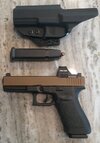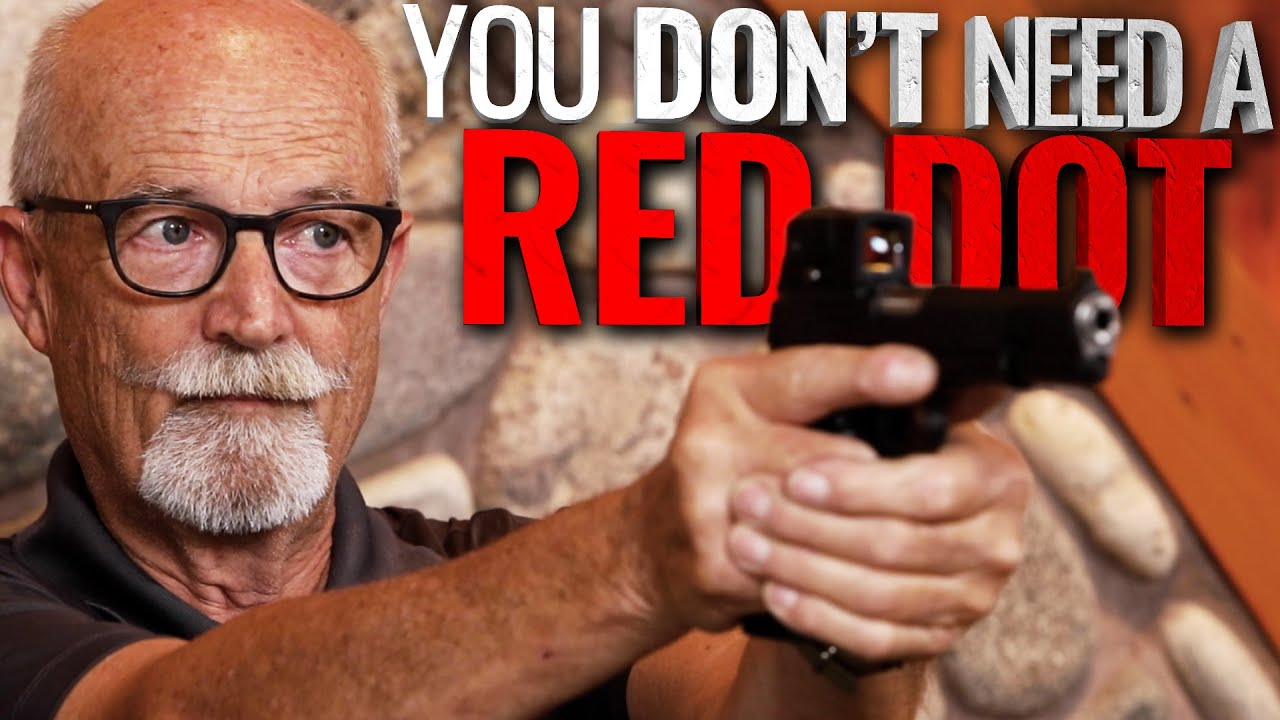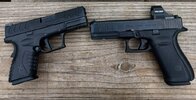Buzznrose
Member
Can we really go by a LEO gun since they are largely required to follow department policy?Optics on a self defense gun? Look at the officers Glock ...
View attachment 1172156
Can we really go by a LEO gun since they are largely required to follow department policy?Optics on a self defense gun? Look at the officers Glock ...
View attachment 1172156
I'm not aware of any departments that mandate a pistol optic but rather those that allow it. I've seen many L.E. who have RMRs and their duty gun and many who don't from the same department....Can we really go by a LEO gun since they are largely required to follow department policy?
LE doesn't count?Can we really go by a LEO gun since they are largely required to follow department policy?

IF the officers got a choice, that makes sense. Not all do.LE doesn't count?
I don't know about that; when I was LE decades ago the dept. still issued revolvers but I carried a personally owned (dept. approved) Glock 17 then 21.
I already posted my 22.5 and now my 20SF - with Holosun 507 - I like the side battery access.
View attachment 1172189
I'm sort of like you. I don't ever see myself putting a RD on a revolver, 1911, or even any none striker-fired handgun. Any classic metal frame handguns will only have irons as well. That said, I still see RD as just another useful tool. IMHO, it's a useful skill to become efficient with both irons and optics whether on a handgun or rifle. I don't see the point in shunning either option.The experience of a friend of mine (who teaches RDS training for line staff users and RDS instructors) is that the average cop shooter, no matter previous experience, can demonstrate a significant benefit in using RDS on duty and off-duty weapons after an 8hr RDS transition training class. By the end of that class virtually everyone is better served using RDS for fast and demanding situations.
Yes, threat focus replaces front sight focus.
The size of the dot matters, too. The 6 MOA dot I tried the other day, turned up high by the owner, wouldn't be my preference.
If I were starting over again, or still working as a cop and serving as an instructor & armorer, I'd be pushing for RDS. I won't be modifying any of my older weapons to accept dots, but if I were buying new pistols I'd look at models that came factory-equipped with RDS.
I won't be giving up my J-frames, though. The other day when I ran a LEOSA qual using one of my M&P 340's, a couple of the instructors commented that a lot of their people would give anything to shoot that well, even with their dots. That course-of-fire involved short distances, though, meaning the longest distance was only 10yds. I'm not sure my eyes would be as sharp if I were to run my J's out to 30-50yds like I did a few years ago. A 2 or 4 MOA dot would likely be nice at those longer handgun ranges with aging eyes, though. Some day a miniature RDS for a J-frame may become an attractive option.
Some officers go the other way. I was talking to one last night that did not want a red dot on his duty gun, and he was tapped by the Sherriff to train everyone on the soon to be mandatory red dots. He is not happy about it.IF the officers got a choice, that makes sense. Not all do.
#1 for sure as my eyesight is getting worse with age.At 60, I put an optic on every gun I reasonably can. Most of my carry guns and all my boonies guns have optics.
Why?
1. I can see BOTH my target and the sight. Nothing is blurry when I press the trigger.
2. I can hit targets much better father out.
3. Adapting to red dot may seem. Like a hurdle to overcome but it really isn’t with a bit of proper practice.
YMMV

Actually, it is the other way around. The truly natural response to a threat is to focus on that threat; that is exactly what a dot lets you do. No more "correcting" your focus from the threat back to your front sight. For all who have spent many years, many hours, learning and practicing front sight focus, it feels unnatural to have a gun up and not focus on the front sight. That is why those who work on RDS training emphasize the need for hundreds or thousands of repetitions to unlearn the unnatural front sight focus. That is also why some assert that starting a new shooter from scratch with a dot will be as easy, or even easier, than traditional sight alignment / picture training.Red dots on pistols is not natural compared to focusing on the front sight.
Actually, it is the other way around. The truly natural response to a threat is to focus on that threat; that is exactly what a dot lets you do. No more "correcting" your focus from the threat back to your front sight. For all who have spent many years, many hours, learning and practicing front sight focus, it feels unnatural to have a gun up and not focus on the front sight. That is why those who work on RDS training emphasize the need for hundreds or thousands of repetitions to unlearn the unnatural front sight focus. That is also why some assert that starting a new shooter from scratch with a dot will be as easy, or even easier, than traditional sight alignment / picture training.
Very nice setup.View attachment 1171892
I have an RMR on my Glock 29. I wanted it to be capable of 50 yard shots against a rifleman ("mass shooter" scenario) and the short sight radius made it much harder than it needed to be.
Cons:
The sight and the slide cut doubled the cost of the gun.
The batteries need to be changed every year or two. In this instance, that requires the sight be removed and then re-zeroed.
A dot sight requires significant training before it becomes as fast and natural as irons.
You may need a new holster.
Now, this should not be taken as an attack on dots for CCW. I believe they have their place. They are not, however, Panacea.
Actually, it is the other way around. The truly natural response to a threat is to focus on that threat; that is exactly what a dot lets you do. No more "correcting" your focus from the threat back to your front sight. For all who have spent many years, many hours, learning and practicing front sight focus, it feels unnatural to have a gun up and not focus on the front sight. That is why those who work on RDS training emphasize the need for hundreds or thousands of repetitions to unlearn the unnatural front sight focus. That is also why some assert that starting a new shooter from scratch with a dot will be as easy, or even easier, than traditional sight alignment / picture training.
Stop making me want that.
That picture causes me to want to go to LGS and pick one ups. This past week, they had 2 on the shelf. A standard model and a performance center model. Looking forward to a shooting report on this setup.
Such an enabler.Stop making me want that.

Silly gimmicky idea to put optics on a CCW.
